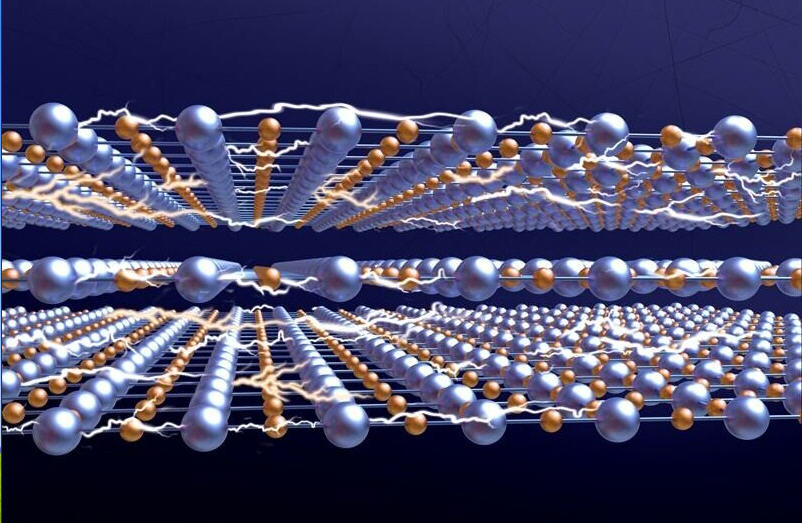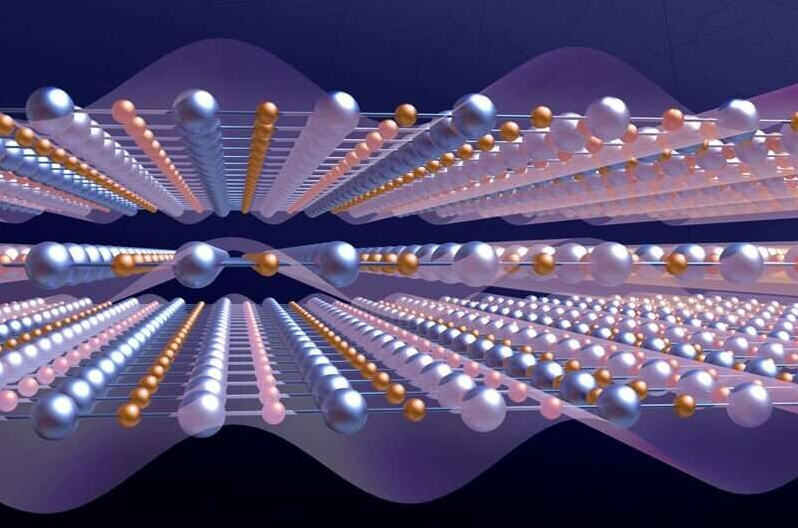 精选
精选
Science:使高温超导体中奇怪的金属状态更加奇怪?
诸平
Fig. 1 Here the copper-oxide planes of the material YBCO are presented in the strange metal phase, where the strong interaction between electrons, the 'quantum entanglement,' is illustrated as lightning. Credit: Chalmers University of Technology | Yen Strandqvist
Fig.2 The copper oxide planes of the material YBCO are presented when the charge density waves appear. Here, the symmetry of the system is reduced by the appearance of these local modulations of the conducting electrons, which cause the suppression of the strange metal phase. Credit: Chalmers University of Technology | Yen Strandqvist
据瑞典查尔姆斯理工大学(Chalmers University of Technology)2021年10月27日提供的消息,来自该校的研究人员发现了高温超导体的“奇怪金属”状态的一种惊人的新行为(Making the strange metal state in high temperature superconductors even stranger)。这一发现代表了理解这些材料的一个重要谜题,该发现于2021年9月24日已在《科学》(Science)杂志网站发表——Eric Wahlberg, Riccardo Arpaia, Götz Seibold, Matteo Rossi, Roberto Fumagalli, Edoardo Trabaldo, Nicholas B. Brookes, Lucio Braicovich, Sergio Caprara, Ulf Gran, Giacomo Ghiringhelli, Thilo Bauch, Floriana Lombardi. Restored strange metal phase through suppression of charge density waves in underdoped YBa2Cu3O7–δ. Science, 24 Sep 2021, 373(6562): pp. 1506-1510. DOI: 10.1126/science.abc8372
超导(Superconductivity)是指电流在传输过程中没有任何损耗,它为绿色技术提供了巨大的潜力。例如,如果它能在足够高的温度下工作,它就能实现可再生能源长距离无损运输。研究这一现象是高温超导研究领域的目标。目前的最高温度是-130℃,虽然看起来不是很高,但与只能在-230℃以下工作的标准超导体相比,确实是很高的温度了。虽然标准超导性已经得到了很好的理解,但高温超导性的几个方面仍然是一个有待解决的难题。最新发表的研究集中在最不为人所知的性质,即所谓的“奇怪金属”状态('strange metal' state),出现在比超导温度更高的温度下。
查尔姆斯理工大学微技术和纳米科学系(Department of Microtechnology and Nanoscience at Chalmers)量子器件物理实验室(Quantum Device Physics Laboratory at the Department of Microtechnology and Nanoscience at Chalmers University of Technology)的Floriana Lombardi 教授说:“这种‘奇怪的金属’状态('strange metal' state)的名字恰如其分。这些材料确实以一种非常不同寻常的方式表现,这在研究人员中是一个谜。我们现在的工作为这一现象提供了新的理解。通过新颖的实验,我们了解了关于这种奇怪的金属状态是如何工作的关键新信息。”
被认为是基于量子纠缠的(Believed to be based on quantum entanglement)
这种奇怪的金属状态之所以得名,是因为它在导电时的行为表面上太简单了。在普通金属中,有许多不同的过程会影响电阻,电子会与原子晶格、杂质或自身发生碰撞,而且每种过程对温度的依赖性不同。这意味着产生的总电阻成为温度的复杂函数。与之形成鲜明对比的是,奇怪金属的电阻是温度的线性函数,即从可达到的最低温度到材料熔化的高温是一条直线。
查尔默斯理工大学物理系的亚原子、高能和等离子体物理教研室的Ulf Gran教授说:“如此简单的行为需要一个基于强大原理的简单解释,对于这种类型的量子材料,原理被认为是量子纠缠。量子纠缠就是爱因斯坦所说的‘幽灵般的远距离作用(spooky action at a distance)’,它代表了一种电子相互作用的方式,这在经典物理学中是没有对应的。为了解释这种奇怪的金属状态的违反直觉的特性,所有的粒子都需要相互纠缠,从而形成一团电子,其中单个粒子无法被识别,并构成了一种全新的物质形式。”
探索与电荷密度波的联系(Exploring the connection with charge density waves)
这篇论文的关键发现是作者发现了是什么泯灭了这种奇怪的金属状态。在高温超导体中,电荷密度波(charge density waves 简称CDW)是由材料晶格中的电子模式产生的电荷涟漪,当奇怪的金属相破裂时就会发生。为了探索这种联系,我们将纳米尺度的超导金属氧化钇钡铜(superconducting metal yttrium barium copper oxide)样品置于应变下抑制电荷密度波。这导致了奇怪的金属状态的再次出现。通过拉伸金属,研究人员能够将这种奇怪的金属状态扩展到之前由CDW主导的区域,使这种“奇怪的金属”更加奇怪。
Floriana Lombardi解释说:“当奇怪的金属相更加明显时,已经被观察到超导转变的最高温度。因此,理解物质的这一新阶段对于能够构建在更高温度下表现出超导性的新材料至关重要。”
研究人员的工作表明,电荷密度波的出现和奇怪金属状态的打破之间存在密切联系,这可能是理解后一种现象的重要线索,并可能代表宏观尺度上量子力学原理的最显著证据之一。这一结果也暗示了一个很有前途的新研究途径,即利用应变控制来操纵量子材料。
上述介绍,仅供参考。欲了解更多信息,敬请注意浏览原文或者相关报道。
Cuprate superconductors host a number of complex phases, and elucidating their relationship to each other may shed light on the nature of cuprate superconductivity. Two of these intriguing phases are the strange metal phase and the charge-density wave (CDW) order, which appear next to each other in the cuprate phase diagram. The hallmark of the strange metal phase, the linear dependence of electrical resistivity on temperature, disappears in the CDW phase. Wahlberg et al. strained thin films of the cuprate YBa2Cu3O7–δ to suppress CDW order (see the Perspective by Le Tacon). Using resonant inelastic x-ray scattering and transport measurements, the researchers found that suppressing CDW restored the linear-in-temperature resistivity in the CDW portion of the phase diagram. —JS
The normal state of optimally doped cuprates is dominated by the “strange metal” phase that shows a linear temperature (T) dependence of the resistivity persisting down to the lowest T. For underdoped cuprates, this behavior is lost below the pseudogap temperature T*, where charge density waves (CDWs), together with other intertwined local orders, characterize the ground state. We found that the T-linear resistivity of highly strained, ultrathin, underdoped YBa2Cu3O7–δ films is restored when the CDW amplitude, detected by resonant inelastic x-ray scattering, is suppressed. This observation suggests an intimate connection between the onset of CDWs and the departure from T-linear resistivity in underdoped cuprates. Our results illustrate the potential of using strain control to manipulate the ground state of quantum materials.
转载本文请联系原作者获取授权,同时请注明本文来自诸平科学网博客。
链接地址:https://wap.sciencenet.cn/blog-212210-1309906.html?mobile=1
收藏




